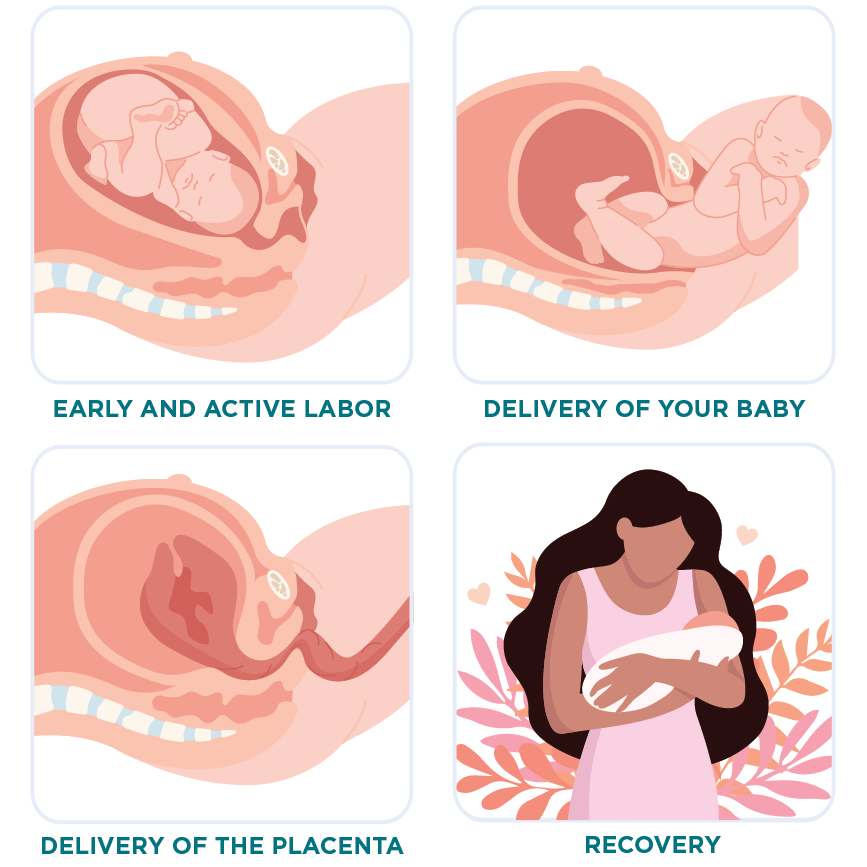
Labor & Delivery
False vs True Labor
Are you unsure if this is really it? In the last weeks of pregnancy, you might feel contractions known as Braxton Hicks. Braxton Hicks, or false contractions, are not as strong and frequent as labor contractions. One way to check if your contractions are Braxton Hicks is to try resting and drinking water. If the contractions go away or ease up, they are most likely not "true" contractions.
True labor contractions come more often and follow a pattern. Timing them helps. Time from the start of one contraction to the start of the next. True labor contractions continue even with rest and will gradually move from the back to the front.
Labor Stages
 Each labor is a unique experience, and you won't know how labor and childbirth
will unfold for you until it happens. However, it can help you prepare
by knowing the four stages of labor:
Each labor is a unique experience, and you won't know how labor and childbirth
will unfold for you until it happens. However, it can help you prepare
by knowing the four stages of labor:
- Stage 1 - Early and Active Labor: The first stage of labor is when contractions are regular and the cervix is completely open (dilated), allowing your baby to move into the birth canal.
- Stage 2 - Delivery of Your Baby: During the second stage of labor, you'll deliver your baby which can take a few minutes to a few hours.
- Stage 3 - Delivery of the Placenta: In the third stage of labor, you will deliver the placenta.
- Stage 4 - Recovery: After the delivery of the placenta, it's time to relax and recover with your baby.
Fetal Monitoring
 Monitoring the health of your baby is our priority. Our Maternal Child
Health team constantly checks the condition of your baby during labor
and delivery. We use a method called fetal heart rate monitoring to spot
any changes in your baby's heart rate and track how your contractions
are going. There are two ways we do this:
Monitoring the health of your baby is our priority. Our Maternal Child
Health team constantly checks the condition of your baby during labor
and delivery. We use a method called fetal heart rate monitoring to spot
any changes in your baby's heart rate and track how your contractions
are going. There are two ways we do this:
- External: Flexible straps are placed around your belly to track the fetal heart rate and monitor your contractions.
- Internal: A thin wire is inserted through the birthing canal and placed by your baby to help monitor the fetal heart rate and your contractions.
Pain Medications
Pain medication can help you better cope with labor and delivery. The use of pain medication does not make your labor “less natural” and will have no long-term effects on your baby. There are two main types of pain medications used:
- Anesthesia (Epidural block): Works by blocking most of the pain and muscle movement below your waist. It can make you feel numb in that area.
- Analgesia (IV/injection pain medication): Helps to lessen the pain without making you completely numb. You'll still feel some sensation and movement, but the pain should be more manageable.
Cesarean Sections
Cesarean section or C-section is the surgical delivery of your baby. This is done through an incision made in your belly and uterus. About one-third of babies are born through C-section, and it's a common procedure when necessary for the health of you or your baby. Some reasons for a C-section include:
-
Arrest of labor progression: When the cervix doesn't open enough for your baby to move down into the birth canal.
-
Concern for your baby: If your baby's heart rate shows signs of distress during labor.
-
Breech presentation: If your baby is positioned feet or buttocks first instead of head first.
-
Baby's size: If your baby is too large to pass safely through your birth canal.
-
Problems with your placenta: Issues with your placenta, such as position of your placenta blocking the opening of the cervix or detaching from the uterus too early.
-
Personal medical condition: If you have a medical condition that makes vaginal birth risky for you or your baby, a C-section might be a safer option.
